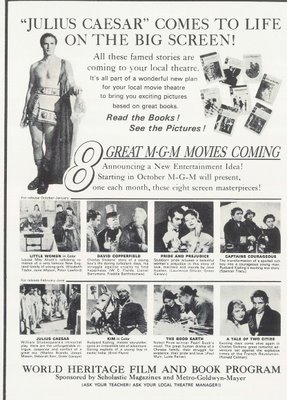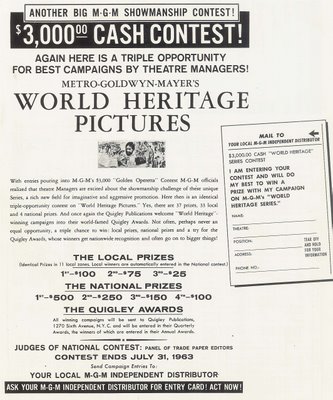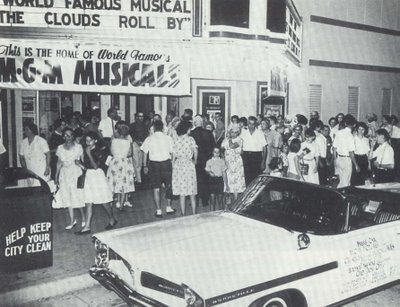 MGM's Perpetual Product Plan
MGM's Perpetual Product Plan There’s nothing an exhibitor likes more than prestige --- except money. Prestige combined with money was a showman’s royal flush, a rarest of happy circumstance where separation of coin from customer walks hand-in-hand with local good will. MGM sold That’s Entertainment in 1974 with a brilliant tagline, Boy, Do We Need It Now!, but here was a campaign along similar lines to predate it, 1962 being a first concerted try at reviving favorites on an organized and sustained basis. Unlike That’s Entertainment, however, the project was forgotten, having left no artifact to mark its place in exhibition history save ads and promotional images. MGM’s Perpetual Product Plan did not revolve around new releases, it was all about re-issues, and nobody got mileage from those like Metro in the 60's. My only regret is that I can’t congratulate showmen responsible for the ingenious plan, but passage of years dictates most having gone by now. The scheme had its launch when MGM went into partnership with a network of independent exchanges in early 1962, the idea to exploit Metro's extensive library of features. Distribution costs were reduced by splitting bounty with local franchisees, dice thrown at limited engagements where smaller theatres paid a flat rental or a reduced percentage. The result was an immediate mop-up. Veteran observers predicted a seven-year release cycle for hits like Ivanhoe and Knights Of The Round Table, combo of which suggested Disney-like evergreen status for the two costume actioners. New trailers, fresh paper, streamlined pressbooks --- this could go on forever!
There’s nothing an exhibitor likes more than prestige --- except money. Prestige combined with money was a showman’s royal flush, a rarest of happy circumstance where separation of coin from customer walks hand-in-hand with local good will. MGM sold That’s Entertainment in 1974 with a brilliant tagline, Boy, Do We Need It Now!, but here was a campaign along similar lines to predate it, 1962 being a first concerted try at reviving favorites on an organized and sustained basis. Unlike That’s Entertainment, however, the project was forgotten, having left no artifact to mark its place in exhibition history save ads and promotional images. MGM’s Perpetual Product Plan did not revolve around new releases, it was all about re-issues, and nobody got mileage from those like Metro in the 60's. My only regret is that I can’t congratulate showmen responsible for the ingenious plan, but passage of years dictates most having gone by now. The scheme had its launch when MGM went into partnership with a network of independent exchanges in early 1962, the idea to exploit Metro's extensive library of features. Distribution costs were reduced by splitting bounty with local franchisees, dice thrown at limited engagements where smaller theatres paid a flat rental or a reduced percentage. The result was an immediate mop-up. Veteran observers predicted a seven-year release cycle for hits like Ivanhoe and Knights Of The Round Table, combo of which suggested Disney-like evergreen status for the two costume actioners. New trailers, fresh paper, streamlined pressbooks --- this could go on forever!Seismic shock came on May 8, 1962, when Danbury, Connecticut’s Stanley Theatre opened MGM’s series of Golden Operettas. Taking its bow before a packed house representing five to ten times normal level of patronage, the venerable songfests played Wednesdays for six weeks, titles including Naughty Marietta, Rose Marie, The Great Waltz, and The Chocolate Soldier. Attendance had been typically slow during mid-week, but these shook the roof, visitors who had shunned the house for years now seeking out management (clad in black tie for the event) to thank him personally for bringing such clean and wholesome family entertainment back to the people. Showmen could use pats on the back during this period of disgruntled parents and civic minded busybodies accusing movies of corrupting youth via new and unwelcome permissiveness. Stanching flow of such criticism was a bargain at thirty-five or forty dollars per booking, figures to ease even minimal attendance toward profit, and small though receipts were, they added up, for such revivals were playing all over the country, small towns and large. Kicker lay in the fact oldies played free on television since 1956, MacDonald/Eddy songfests long familiar to home viewers, yet here patrons came, cheerfully paying admission to see favorites again. Families That Go To The Movies Together --- Stay Together became Metro’s mantra. Little did they realize that these Operettas were only the locomotive that would drive a veritable money train.



Campaign manuals said The Best Music Is The Cash Register, and MGM’s next trip to the well was its so-called World Heritage Pictures, two sets of six "movie masterpieces", again most of them pre-48 titles that had been wrung dry on TV, though you’d not know it from crowds on line. This time, they went after school groups. Public libraries and local opinion-makers were pressed into shilling service on behalf of Captains Courageous, The Good Earth, David Copperfield, more along literary lines. Busloads of students rolled up for Julius Caesar, and since this was adjudged quality fare, the field trips were school sanctioned and took place during what would have otherwise been classroom hours. Resulting windfall to exhibitors both guaranteed pre-arranged full houses and a booming traffic in concessions, kids otherwise bored with twenty and thirty year old black and white movies lured by the sweet aroma of popcorn and sweets. What a culture shock for teens accustomed to the Troy Donahues and Sandra Dees to suddenly be confronted with Ronald Colman and Luise Rainer on their neighborhood theatre screen. There was even a National Advisory Committee Of Educators Of "World Heritage Film and Book Program." Now there’s a mouthful for someone’s resume. High school teachers, collegiate profs, even parish priests, got in on the push. There was plenty of good citizenship to go around. Third and last of the series was the World Famous Musical Hits group, which may well have been the most popular of all, as it included show-stoppers along the lines of Singin’ In The Rain and The Bandwagon. Radio deejays proved effective allies in spreading the word, soundtrack album giveaways the order of the day, rock n’ roll inundated youth discovering vintage Fred Astaire and Judy Garland. Astaire’s dance studio namesake cashed in as well, tie-ins offering near-limitless possibilities. New prints were made for whole of the Operetta-Heritage-Musicals lot, MGM keeping them in service for another twenty years in case individual venues called for any. I was still seeing Perpetual Product Prints at theatres in 1981, despite a Metro exchange man telling me a few years earlier that most of the 35mm had been junked so as to conserve space or shut down offices altogether. Home video would be a next cash-in for the deep library, fans at last able to own movies they had revered so long.


That Bonneville convertible bearing "Miss MGM Musicals Of Columbia, S.C." may as well have been on its way to the bank, judging by the look of satisfaction on the driver/exhibitor’s face. Here it is parked in front of Columbia’s Five Points Theatre for the gala opening of Till The Clouds Roll By, and bear in mind, this is 1963, not 1946. Read The Books --- See The Pictures was the magic phrase that forged alliance between schools and movie houses during brief truce they enjoyed as the result of Metro’s World Heritage series, on-the-ball exhibitors getting further incentive with this cash contest for salesmanship brainstorms. The audience survey shown here was genuine, and I wonder if Mrs. Bert A. Swanson, assuming she’s still with us, remembers her happy hours with Rose Marie back in 1962. The Della Theatre in Flint, Michigan was boffo for Till The Clouds Roll By as well. Wonder if attendees realized this movie had played television for seven years prior to their surrender of a ticket price? The Uptown in Pasadena, CA saw attendance jump when they paired The Merry Widow (1934) with The Great Waltz (1938) in May 1964. Management was gratified by respectful conduct of moppets in the audience. Could it have been hovering teachers in the auditorium that quelled youthful hijinks? The Wellmont in Montclair, NJ had been servicing the local "action" market when they switched policy in favor of Julius Caesar and the Heritage group. Possibly manager Harry A. Weiner got tired of chasing drunks and hop-heads out of their fifth viewing of Hercules and The Captive Women before cleaning their waste, bodily and otherwise, off the floors. How could MGM classics be anything other than a step up for Harry?



Campaign manuals said The Best Music Is The Cash Register, and MGM’s next trip to the well was its so-called World Heritage Pictures, two sets of six "movie masterpieces", again most of them pre-48 titles that had been wrung dry on TV, though you’d not know it from crowds on line. This time, they went after school groups. Public libraries and local opinion-makers were pressed into shilling service on behalf of Captains Courageous, The Good Earth, David Copperfield, more along literary lines. Busloads of students rolled up for Julius Caesar, and since this was adjudged quality fare, the field trips were school sanctioned and took place during what would have otherwise been classroom hours. Resulting windfall to exhibitors both guaranteed pre-arranged full houses and a booming traffic in concessions, kids otherwise bored with twenty and thirty year old black and white movies lured by the sweet aroma of popcorn and sweets. What a culture shock for teens accustomed to the Troy Donahues and Sandra Dees to suddenly be confronted with Ronald Colman and Luise Rainer on their neighborhood theatre screen. There was even a National Advisory Committee Of Educators Of "World Heritage Film and Book Program." Now there’s a mouthful for someone’s resume. High school teachers, collegiate profs, even parish priests, got in on the push. There was plenty of good citizenship to go around. Third and last of the series was the World Famous Musical Hits group, which may well have been the most popular of all, as it included show-stoppers along the lines of Singin’ In The Rain and The Bandwagon. Radio deejays proved effective allies in spreading the word, soundtrack album giveaways the order of the day, rock n’ roll inundated youth discovering vintage Fred Astaire and Judy Garland. Astaire’s dance studio namesake cashed in as well, tie-ins offering near-limitless possibilities. New prints were made for whole of the Operetta-Heritage-Musicals lot, MGM keeping them in service for another twenty years in case individual venues called for any. I was still seeing Perpetual Product Prints at theatres in 1981, despite a Metro exchange man telling me a few years earlier that most of the 35mm had been junked so as to conserve space or shut down offices altogether. Home video would be a next cash-in for the deep library, fans at last able to own movies they had revered so long.


That Bonneville convertible bearing "Miss MGM Musicals Of Columbia, S.C." may as well have been on its way to the bank, judging by the look of satisfaction on the driver/exhibitor’s face. Here it is parked in front of Columbia’s Five Points Theatre for the gala opening of Till The Clouds Roll By, and bear in mind, this is 1963, not 1946. Read The Books --- See The Pictures was the magic phrase that forged alliance between schools and movie houses during brief truce they enjoyed as the result of Metro’s World Heritage series, on-the-ball exhibitors getting further incentive with this cash contest for salesmanship brainstorms. The audience survey shown here was genuine, and I wonder if Mrs. Bert A. Swanson, assuming she’s still with us, remembers her happy hours with Rose Marie back in 1962. The Della Theatre in Flint, Michigan was boffo for Till The Clouds Roll By as well. Wonder if attendees realized this movie had played television for seven years prior to their surrender of a ticket price? The Uptown in Pasadena, CA saw attendance jump when they paired The Merry Widow (1934) with The Great Waltz (1938) in May 1964. Management was gratified by respectful conduct of moppets in the audience. Could it have been hovering teachers in the auditorium that quelled youthful hijinks? The Wellmont in Montclair, NJ had been servicing the local "action" market when they switched policy in favor of Julius Caesar and the Heritage group. Possibly manager Harry A. Weiner got tired of chasing drunks and hop-heads out of their fifth viewing of Hercules and The Captive Women before cleaning their waste, bodily and otherwise, off the floors. How could MGM classics be anything other than a step up for Harry?
Once again, I thank Dr. Karl Thiede for sharing his knowledge and expertise in the area of distribution and exhibition, very much specialties of his.



I am from Columbia, SC and that theater in Five points is now home to a night club. By the way from that picture I don't believe that the car is parked in front of the theater. The building in the picture looks like a building downtown (just a little ways from Five Points), but I could be mistaken. Five Points now is the university's (U of S.Carolina) club, bar, and restaurant scene. The theater you mentions still has the structure of the marquee up, but it is covered with a neon sign for the club. Sad. The last great marquee theater in Columbia, the Jefferson Square Theater folded up in the 90s. Fortunately when I was in High School I was able to see several classic films there when they were running some "anniversary" revivals in the late 80s- Gone With the Wind, Wizard of Oz, and Casablanca. Nothing compares to sitting in a "balconied" theater mesmerized by a classic on the largest screen I have ever laid eyes on. And I am glad to have had the experience even if some nights the only patrons were me and my friends.
ReplyDeleteBoy do we need this NOW! Why don't they do it again? I haven't gone to a movie theater for years...and I miss the big screen experience. But price increase + movie quality decrease = me no go.
ReplyDeleteStudios are complaining 'cause ticket sales have been down right? And no wonder, with all the crappy, uninspired and unnecessary remakes being made. Damn, I'd go to the movies again if they re-released the original classics - oh the thrill of seeing a truly GREAT old movie on the big screen... I have an inkling what it would be like, since I saw That's Entertainment III at my local art-house theater - very exciting. :)
Even with DVD business booming, I think theater revivals of these classic films would work - after all, nothing can compare to watching a film on the really big screen with a rapturous crowd. And if the availability of these films on TV didn't hinder theatrical reissues back in the '60s, I doubt DVDs would hurt things now! :)
Why, the theatrical showing could help PROMOTE the DVDs! Give new generations a chance to check out the movie for a lower price, and maybe they'll fall in love with it and buy the DVD later. Gee, they could even sell DVDs *in* the theaters. Oooh, I'm excited now. ;) After all, not many people can afford to blind-buy movies they're not familiar with.
It sure seems like all the reasons for doing it back then, exist again today. The need for family friendly outings, etc. There's not much on TV that parents can safely let their kids watch. Turner Classic Movies, if they get that channel. Although that could change, with TCM running more contemporary adult-oriented films lately... plus upcoming additions of "classic" blaxploitation and skin flicks. Oh boy.
Christine
Hey Christine, if I-who am on social assistance-can go to a movie twice each month, so can you! Just go tho the independent beyond first run theaters, which charge less money (look in the local papers for where they are.)Then you can enjoy a new movie at reduced prices-epic win on all fronts.
ReplyDeleteAs for you, Anonymous, may I suggest an investment in a home theater system complete with a Blu-Ray DVD player, and all of the specific movies in Blu-Ray? That works a lot.
In my sophmore year,the European history teacher decided to take his 5 classes of high school students 3 blocks downtown to the rerelease or DR ZHIVAGO....again it was a week day afternoon and it was packed....total mayhem for 3 hours!!! The management must have laughed all the way to the bank!!! And yes,we were in the balcony. ....
ReplyDelete